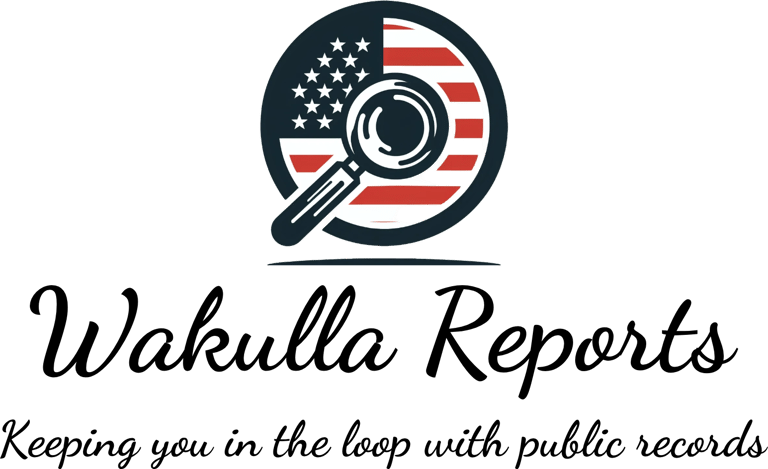Wakulla County's Debt Shell Game: Breaking Rules, Burning Reserves, and Billing Taxpayers
We dug into Wakulla County’s 2024 Debt Report — and it paints a picture of overspending, rule-bending, and a scramble to rebuild reserves that were drained along the way.
MONEY & FINANCE2025
Ida B. Wells
10/7/20257 min read


Hey, Wakulla neighbors—it's me, your fellow taxpayer who's tired of sifting through county PDFs while trying to pay the mortgage. If you've been following the local chatter you know the Board of County Commissioners (BOCC) just wrapped up their FY2025/2026 budget with no property tax relief, a trash fee hike, the death of curbside recycling, and a 3% employee raise to offset skyrocketing health premiums. "Unavoidable costs," they say. But here's the kicker: This squeeze didn't come from nowhere. It stems from a debt binge in 2023 that violated their own written rules, drained our funds, and now has officials scrambling to refill the coffers—on our dime.
Today, I'm deep-diving into the finally released 2024 Annual Debt Report (fiscal year ending September 30, 2024 - that takes some time to gather), prepared by Clerk of Court Greg James. I'll break it down like we're chatting over coffee: what the numbers say, how they ignored their Debt Policy (pulled straight from the county's administrative rules), the sneaky violations that happened under our noses, and why this spells trouble for everyday folks like you and me—John Q. Public, scraping by in Crawfordville or St. Marks. No jargon overload, promise. Just facts, charts (described for you), and a wake-up call.
If you're new here, grab a seat. This is long because the truth doesn't fit in a social media post. Let's unpack how our county went from "prudent borrowing" to a $36 million debt bomb, paid it down with our savings, and is now hiking fees to rebuild what they broke, all while telling you this was "PLANNED". Oh, and we brought you the links in green to see for yourself! Don't take our word for it.
First, the 2024 Debt Report: A Polished Facade of Fiscal Prudence
The report—20 pages of glossy charts and reassuring words from Clerk James—paints a picture of a county that's "handling debt like a pro." Total outstanding debt as of September 30, 2024? $21.9 million, down a whopping $14.5 million from $36.3 million the year before. They paid $19.9 million in principal and interest that year—51% of the starting balance in principal alone. Interest? A "low" $1.2 million (5.6% of the balance). Sounds great, right? Like they refinanced the house and paid extra on the mortgage.
But zoom in, and it's less "win" and more "survival mode." The big drop? Mostly from reimbursements on a $30 million line of credit (LOC) with JP Morgan, drawn in May 2023 to front-load grant-funded projects (think wastewater expansions, roads, and infrastructure). They borrowed big to "cash flow" federal/state grants that reimburse later—smart in theory, but it required burning through reserves while waiting. The report brags about earning $854K in investment income on idle LOC funds to offset $1.2 million in interest, netting just $737K in costs. Noble, but it glosses over the interim chaos.
Debt Breakdown by Type (Pie Charts from the Report):
By Activity: 46% ($10.1M) governmental (tax-funded stuff like roads and general ops); 54% ($11.7M) business-type (sewer/trash fees). Both down, but business-type still dominates.
By Instrument: 67% notes/loans ($14.7M, mostly banks); 28% bonds ($6.1M, low-rate USDA for wastewater); 5% capital leases ($1.1M, "rent-to-own" for fire trucks and graders).
By Lender: JP Morgan (55%, $12M LOC); USDA/Ameris (28%, $6.1M bonds); smaller slices for landfill loans, equipment leases, and a new $1.8M DEP planning loan (which might get forgiven—fingers crossed).
10-Year Trends (Line/Bar Charts):
Debt averaged $12M/year since 2015, but spiked to $36M in FY23 (LOC draw). Lowest ever: $2.9M in 2016. Net increase: 332% over decade.
Payments averaged $3.2M/year, but FY24 hit $20M (that big principal slam). Split roughly even between governmental and enterprise funds.
The report nods to "health checks": Debt per capita at $589 (down from $1,024), service as 15-20% of ops budget, coverage ratios scraping by. Clerk James ends with a bow: "Dedicated to transparency." But buried in the fine print? Admissions that ratios "remain above benchmarks" and funds "relied on cash reserves" for payments (See page 17 in the report). That's code for: We broke the rules, fixed it with your savings, and now we're rebuilding—pass the hat.
For the full report, download it from the Clerk's site here—it's unaudited, so it won't match the official financials, but it's the "citizen-friendly" version.
The Rules They Wrote (But Didn't Follow): Wakulla's Debt Policy Exposed
To understand the mess, we need the rulebook. Wakulla's Administrative Regulation 3.02: Debt Policy, adopted January 20, 2015, by the BOCC, is their self-imposed bible for borrowing. It's part of Chapter 3 (Finance) in the county's administrative regulations, hosted on the official site at MyWakulla.com.
No dusty tome—this is a living document meant to "promote sound financial management" and "provide guidelines for the issuance and management of debt."
From the policy (cross-referenced in annual debt reports and county docs):
Purpose: Ensure debt is used only for capital (not ops), keeps costs low, and protects credit ratings. Debt's okay—like your car loan—but not if it starves services or spikes taxes.
Objectives: Minimize interest costs, maintain flexibility, comply with laws, and monitor via annual reports.
Key Guidelines:
Borrow only after exploring grants/cash options.
Favor fixed rates over variable (to avoid surprises).
No more than 40-year terms for infrastructure.
Get competitive bids for loans/bonds.
Track "benchmarks" annually—if breached, explain and fix.
The Big Benchmarks (The Guardrails They Smashed):
Outstanding Debt Per Capita: ≤ $500 per resident. Measures if borrowing outpaces growth—keeps it "affordable."
Debt Service to Operating Expenditures: ≤ 15% overall (principal/interest can't hog more than 15% of your tax/fee dollars).
Debt Service Coverage Ratio (DSCR): ≥ 1.15x for enterprise funds (e.g., sewer). Revenues must cover payments 1.15 times; below 1.0x? You're underwater, dipping into savings.
Fund Balances/Reserves: Tie-in from AR 3.01—maintain 10-25% of expenditures as rainy-day cash to backstop debt without tax hikes.
These aren't suggestions; they're "parameters to monitor the County's debt burden." Breaches trigger reviews. The policy hasn't been updated since 2015 (hello, inflation—$500 today feels like chump change next to Florida's $6K state average), but it's the law they voted in.
How They Did It: The LOC Debacle and Policy Violations Step-by-Step
Flashback to spring 2023: Growth booms (pop up 5%/year), grants flow ($110M pipeline for roads/sewers), but reimbursements lag. Solution? BOCC approves a $30M LOC with JP Morgan at variable 4.24%—a "bridge" to front projects. Noble? Sure. Policy-compliant? Hard no.
Here's the timeline of rule-breaking, pieced from the 2024 report, prior audits, and BOCC minutes:
The Spike (FY23: May 2023 Draw):
Drew nearly the full $30M for "cash flow." Debt jumps from ~$6M to $36.3M.
Violation #1: Per Capita. Pop ~35,500; debt/capita = $1,024 (105% over $500). Report calls it the "highest recorded"—no debate, no waiver vote. Policy says this flags "decreasing flexibility," but they plowed ahead.
The Strain (Mid-FY23 to Early FY24):
Variable rates bite; interest/fees hit $1.6M while grants trickle. Sewer fund DSCR? 0.15 (revenues cover 15% of payments—disaster). Revenue Stabilization? 0.04. Road Fund? 1.02 (below 1.15).
Violation #2: DSCR. Enterprise funds (53% of debt) tank below 1.15x, relying on reserves for $18M+ in service. Policy: "Ensure the County can meet requirements" without draining cash.
Violation #3: Debt Service %. Business-type funds hit 30.6% average (double 15%); projected FY25: 460%! Overall, payments eat 15-20% of ops—teetering on the edge.
The "Paydown" (FY24: Grant Reimbursements):
$18M in grants roll in; principal drops to $12M on LOC. Total debt: $21.9M. Per capita: $589 (still 18% over).
But reserves? Scorched. Funds "relied on cash" per report—exact burn unknown, but audits show general fund balances dipped below 20% target. Policy's fund balance rule? Flexed to the breaking point.
Watch the 25/26 Budget Meeting that outlines the negative cash balances here. You can also watch the Waste Pro Rate Increase Contract Approval Regular Wakulla County BOCC Meeting August 18, 2025 meeting at timestamp 3:43 where the administrator speaks about the sewer fund needing to be replenished.
No fines, no headlines—just a footnote in the report: "The LOC has impacted this ratio... expected to remain above 15%." Clerk James' office helped structure it, but the BOCC pulled the trigger without public input on breaches. Minutes from April 2023? Crickets on policy limits.
Why It's a Problem for John Q. Public: Your Wallet, Your Services, Your Trust
This isn't abstract bean-counting—it's your money, your roads, your future. Here's why the violations hit home:
Higher Bills Now: Reserves drained means no buffer for tax cuts. FY25 millage? Stuck at 7.9 (above rolled-back), adding $200-300/year to a $300K home's bill via 8-10% value growth. Trash fees? Up 7% to $24/month—no recycling curb service (haul it yourself to the landfill). Sewer rates? CPI bumps to chase DSCR. Employee raises? 3% COLA ($1.2M) covers 15% health premium spikes—fair, but funded by us.
Risky Borrowing Ahead: $100M+ projects queued (sewer upgrades, admin building (which will need to be moved to accommodate 319 expansion)). Per capita projected to climb; new debt (e.g., $7.5M by FY28) pushes service % higher. Variable LOC rates? If they spike (hello, Fed hikes), we're on the hook. Breaches erode credit ratings—next loan costs more.
Service Squeeze: Low DSCR (Debt Service Coverage Ratio) starved sewer/trash funds—hence axing recycling (costs doubled since 2020). Reserves thin? One hurricane, and we're borrowing more at bad rates, delaying pothole fixes or EMS stations.
The Trust Erosion: Policy's for us - transparency vow. Ignoring it? "Do as I say, not as I do. With population booming, unchecked debt means your kids pay for today's "bridges."
Bottom line: They bet on grants (risky), broke rules to cover, burned your savings, and now rebuild via fees/taxes. It's a shell game—debt down on paper, but your checkbook lighter.
What's Next? Projections and the Path Forward
The report's crystal ball: Debt stabilizes $15-20M over 10 years, payments $2-3M/year. But with breaches unaddressed, watch for policy "updates" (read: loosening caps). FY26 budget talks will start soon—radio upgrades, more infrastructure.
Wakulla, you've got the power.
We're not anti-growth; we're pro-smart. Share this, ask questions.
Clerk James: Props for the report—now enforce the rules.
BOCC: Fix the breaches before the next LOC tempts you.
What do you think? Debt savvy or taxpayer shaft? Stay vigilant, friends.
Sources: See Links in Green Above

Additional Social Links
YouTube is your go-to for short clips, video explainers, and visual breakdowns of how Florida and Wakulla governments really work.
Facebook brings you bite-sized written content, sticky-note facts, and rolling updates you can share and discuss.
Prefer to browse at your own pace?
Bookmark our website and visit anytime for fresh posts, resources, and real-life examples from right here in Wakulla County.
© 2024. All rights reserved.
